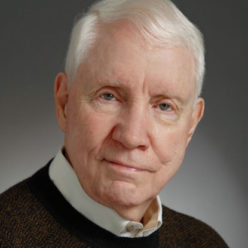[Published: Summer 2002]
(This editorial was written for Santa Barbara’s Green Party newsletter.
In the subsequent 20 years, has your government or mine made any significant environmental effort to save our civilization –
and our grandchildren’s lives?)

The hottest year on record for this planet was 1998. The second hottest was 2001.
Why?
Throughout the South and Southwest of the US areas unprecedented in scope are being consumed by raging, drought-driven wildfires. “I cannot tell you how serious this is,” said Arizona Governor Jane Dee Hull, ”this is like a freight train coming at us.”
Why?
In the year 2001, the world’s best climate scientists cooperated to produce the Third Assessment of the Intergovernmental Panel on Climate Change.
This massive report, the product of three Working Groups, was put into final form at conferences held in Shanghai, Geneva and Accra. Assessing the content of the first three of its four volumes for the New York Review of Books (July 5, 200I), Bill McKibben wrote, “They distill millions of man hours of work on the future of the climate into a readable and understandable summation that argues, in a measured but urgent scientific tone, that we stand on the edge of cataclysm.”
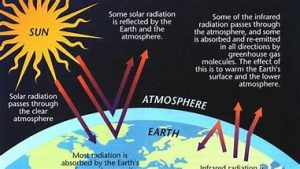
The idea that the earth is warming due to human activity was first widely circulated in this country by James Hansen, a National Aeronautics and Space Administration scientist, in the I980’s, when his computer modeling indicated that the release of carbon dioxide – a byproduct of humans’ burning of coal, oil and natural gas – is resulting in an ever-increasing accumulation of CO2 in our upper atmosphere. Normally, heat and light generated by the sun penetrate to the surface of the earth and a portion of this energy is reflected as infrared radiation back into space through our atmosphere. But the molecular structure of carbon dioxide is such that it prevents some of this reflected radiation from escaping. Trapped as though by a blanket, the accumulating energy acts to increase the temperature of our planet’s atmosphere, earth and water. Hansen’s work led him to believe, too, that this “greenhouse effect” would rapidly accelerate.
The theory had plenty of skeptics. But concern as to the possible, and profoundly serious, consequences should it prove true led many nations to devote millions of dollars over a period of years to research the matter. The Intergovernmental Panel on Climate Change, established in 1988 under the aegis of the United Nations, became the formal vehicle for the summation of this accumulating research.
What credence should we give to the work of lPCC scientists? How thorough, how sound is their approach?
Every five years, almost one hundred governments nominate their best climatologists to participate in this research. From these thousands, the IPCC selects several hundred for each of three working groups, basing their selections on the scientists’ published work. Each scientist is given the job of reviewing all the scientific literature on a particular facet of the problem. All participants’ work is then reviewed by other scientists. By the end of the five-year period, approximately 1500 experts have been involved in the process.
After still further review, and then condensation of the material, a plenary session of representatives of the worlds’ governments scrutinize the final document line by line. The result is a consensus report having unanimous approval.
What are these scientists telling us?
In 1995, the Second Assessment of the IPCC concluded “the balance of evidence suggests a discernible human influence on global climate.”
“Though couched in the quiet language of science,” wrote McKibben, ”this was the first official recognition that human beings had become numerous enough, and industrialized enough, as a species to produce emissions that would radically alter the most fundamental force of the planet’s surface.”
In the Third Assessment of 2001, Working Group I concluded, “there is new and stronger evidence that most of the warning observed over the last 50 years is attributable to human activities.”
 They predict that in this century the average global temperature will rise by 3 to 11 degrees Fahrenheit. (In 1995 they had estimated an average increase of 2 to 6 degrees.) The range of the current prediction is meant to allow for differences in the growth rate of large economies and how quickly these economies would make the transition to non-carbon sources of energy.
They predict that in this century the average global temperature will rise by 3 to 11 degrees Fahrenheit. (In 1995 they had estimated an average increase of 2 to 6 degrees.) The range of the current prediction is meant to allow for differences in the growth rate of large economies and how quickly these economies would make the transition to non-carbon sources of energy.
The current average global temperature is 59 degrees Fahrenheit. What difference does it make to anyone if it rises to 65 or 70 degrees? Why should we care?
So far, these scientists tell us, the average global temperature has risen one degree since the late 19th century. What do we observe now?
Arctic sea ice is 40% thinner than it was 40 years ago. Throughout the Northern Hemisphere, ice on lakes forms a week later and melts a week earlier than it did a century ago. The timing of the flowering of plants, the nesting and egg-laying patterns of animals are noticeably changing as the earth warms. In our hemisphere the amount of rain has increased, by some estimates as much as 20%; the resulting floods and storms have cost the insurance industry 30 billion dollars from 1990 -1995 as opposed to 2 billion in the I980’s. El Nino storms have become more frequent and more intense since the I970’s. Coral reefs, necessary to sustain a rich variety of ocean life but highly sensitive to temperature change, are being destroyed. A wide variety of plants and animals are succumbing to new or more virulent disease due to even small increases in temperature.
Our own state of Alaska provides a striking preview. Mean temperatures in that state, in contrast to the global average, have risen 5 degrees in summer and 10 degrees in winter since 1970s. Whole forests in that state are dying, the trees either drowning at root level from melting permafrost rising to the surface, or destroyed by bark beetles whose population is exploding because of the warmer climate. 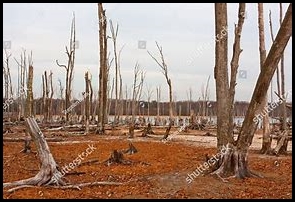
On the Kenai Peninsula, destruction of 95% of the 4-million-acre spruce forest by insects is the greatest in the recorded history of North America. As a consequence, residents face the prospect of catastrophic fire fueled by 38 million dead trees.
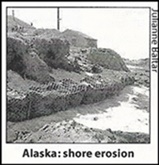
Homes in Alaska built on the now-melting “permafrost” are buckling. Along the shores of the Bering, Chukchi and Beaufort Seas, melting sea ice has spurred increased wave action, which has so extensively eroded no-longer-frozen shorelines and so undermined seaside homes and businesses that the town of Kivalina will soon have to move, and on July 19 residents of Shishmaref will vote whether to move their barrier-island village inland. Residents of Barrow, the state’s northernmost city, are coping for the first time in their history with mosquitoes.
What does the future hold? Working Group II of the IPCC tells us that in this century the crop yields of tropical and subtropical regions, where food is scarce, will decrease. Because a warmer atmosphere absorbs and holds more moisture, there will be greater evaporation from arid areas, depriving them of what little water they have. This moisture-laden air, paradoxically, will dump its load as increased rainfall in other regions of the earth.
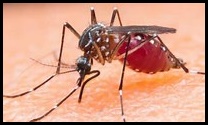 Since a warmer, wetter world provides perfect breeding conditions for mosquitoes, malaria and dengue fever, carried by these insects, will spread. “It’s not only going to be a warmer world, it’s going to be a sicker world, ” said Andrew Dobson, Princeton University epidemiologist and co-author of a study published in the journal Science (June 21, 2002) that has found temperature-related epidemics to have wiped out oaks, oysters, butterflies and birds. The implication of course is that humans are not immune.
Since a warmer, wetter world provides perfect breeding conditions for mosquitoes, malaria and dengue fever, carried by these insects, will spread. “It’s not only going to be a warmer world, it’s going to be a sicker world, ” said Andrew Dobson, Princeton University epidemiologist and co-author of a study published in the journal Science (June 21, 2002) that has found temperature-related epidemics to have wiped out oaks, oysters, butterflies and birds. The implication of course is that humans are not immune.
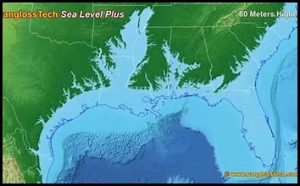
The level of the ocean will rise as much as 3.3 feet, which would inundate many areas of the earth, including 6,630 square miles of the U.S., equal to the combined land masses of New Jersey and Connecticut. There is some evidence that in the past, a warming of 4 degrees caused the destruction of the West Antarctic Ice Sheet; should this destruction recur, the melting ice would raise the ocean level 16 feet. And there is the possibility that the Gulf Stream, that warm ocean current which flows from the Gulf of Mexico northeast through the Atlantic Ocean to northwest Europe, could slow, actually leaving the United Kingdom and parts of Europe as cold as Canada.
What then is to be done? How do we forestall or slow this creeping alteration to the nature of the earth, making of it a planet no human being will ever have lived on?
Working Group IIII of the IPCC, which examined methods for reducing the flow of carbon dioxide and other greenhouse gases into the atmosphere, concluded that all attempts to mitigate and stabilize their concentration must be “characterized by the introduction of efficient technologies for both energy use and supply, and of low or no-carbon energy.“
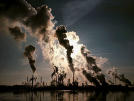
In other words, we have to stop burning fossil fuels: coal, oil and natural gas! We must increase, and eventually rely on, other, non-carbon sources of energy, sources that will in any practical sense always be available to us: the sun, water, wind.
In the short term, we must drastically reduce our consumption of fossil fuels, drastically reduce our use of energy produced by them. We must stop planning cities around vehicle use, drive less frequently and more slowly, carpool and/or take public transportation. We must make it fashionable not to buy gas-guzzling SUVs and make legislators compel manufacturers to meet the fuel efficiency standards of automobiles rather than trucks. We must continue stringently to conserve our use of electricity, not because there is any longer an “energy crisis”, but because that power is largely produced by fossil fuels. And we must see to it that factories, manufacturing processes, appliances, vehicles and engines dependent on coal, oil and natural gas make much more efficient use of them. While planning, and acting, to rid ourselves of our dependence on fossil fuels, we must make these fuels go further, do more!
How much must we reduce our emissions of carbon dioxide just to stabilize the degree of warming at its current level? Scientists’ rough estimate, used over the last five years: 60% to 80%.
Are we doing this? Are we reducing our production of CO2 by 50%? 5%? I%?
No.
We are increasing our use of fossil fuels, insuring that the levels of this byproduct gas will rise for years to come. “There is despair among scientists,” wrote McKibben, “of preventing its rise short of 560 parts per million, double the concentration in our atmosphere before the Industrial Revolution.”
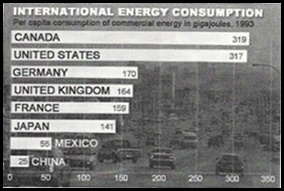
The United States is responsible for one-quarter of the world’s carbon dioxide emissions. What is our government doing to address the problem of this impending “cataclysm.”

In 200I, at the request of President George W. Bush, the National Academy of Sciences reviewed the Third Assessment of the intergovernmental Panel on Climate Change – and confirmed the validity of its conclusions.
The president, therefore, has:
- Reneged on his campaign pledge to phase in limits on power plant emissions for four pollutants: mercury, sulfur dioxide, and the “greenhouse gases” nitrogen oxide and carbon dioxide (the chief agent of global warming).
- Caused the United States to withdraw from the Kyoto Protocols, a proposed agreement among world governments by which industrialized nations would reduce greenhouse emissions by a modest 5.2% between 2008 and 2012 – a proposal now ratified by the 15 countries of the European Union and by Japan.
- Issued a national Energy Policy calling for increased construction of coal-burning power plants, vastly increased production of oil and gas – thereby treating energy requirements as though they existed in a vacuum and should be dealt with through increased supply of the usual kind, ignoring the known global effects of CO2, thumbing this government’s nose at the urgent request for reduction in greenhouse emissions called for by the IPCC scientists. Going further, on June 13, 2002 the administration’s Environmental Protection Agency proposed “reviewing” the regulation by which coal-fired energy plants could be upgraded/rebuilt only if they complied with stricter pollution standards. The president’s plan, therefore: continue to excavate the earth for energy and bum it as we have been doing for 200 years, keep spewing CO2 into the upper atmosphere, the health and safety of present and future generations be damned.
Imagine, if you will, a cabinet meeting of George Washington, Thomas Jefferson and James Madison being told what George W. Bush now knows of the threat posed to our earth by global warming. Can you picture them joining voices to sing, “I Don’t Care”?
 The Clinton administration had also sat on its hands. Promising to hold the line on carbon dioxide emissions, it did nothing of the kind. No increase in the price of conventional fuels, no substantial sums devoted to alternative energy sources, no legislation mandating increased automobile fuel efficiency. In 2000 the US produced 12% more CO2 than it had in 1990.
The Clinton administration had also sat on its hands. Promising to hold the line on carbon dioxide emissions, it did nothing of the kind. No increase in the price of conventional fuels, no substantial sums devoted to alternative energy sources, no legislation mandating increased automobile fuel efficiency. In 2000 the US produced 12% more CO2 than it had in 1990.
The bottom line as to these evasions and omissions by your elected representatives and mine is “the bottom line,” and is immortalized in the pronouncement of then Vice President Al Gore, author of Earth in the Balance: “The minimum that is scientifically necessary [to combat global warming] far exceeds the maximum that is politically feasible.”
A different view has been taken by the European Union and Japan, as mentioned above, and especially by the Dutch and Scandinavians, who have constructed national energy plans to divest themselves of the use of fossil fuel by the middle of this century. Perhaps the Dutch are driven by concern that their low-lying country would be among the first to be devastated? Or is it also possible that the hearts and minds of these nations’ leaders are directed by something other than the wishes of campaign contributors?

There are some effective methods of reducing fossil fuel consumption whose cost would be minimal and hidden in the price of the product. The Clinton administration, towards the end of its mostly do-nothing eight years, proposed standards to increase the efficiency of appliances: air conditioners, refrigerators, washing machines, water heaters and light bulbs. Faithful implementation of these new standards would have a substantial and beneficial effect: by some accounts the energy savings by 2010 would be enough to light all American homes for two years. President Bush, however, is scaling back some of these standards.
It’s true that if our communities’ electricity were provided by municipal utility districts, we might pay somewhat less for energy, but if that power is produced by natural gas turbines, as it largely is now in California, how does that do anything to alleviate global warming? It’s also true that if we install solar panels on our homes, businesses and government buildings – and we should – the cost would eventually be recouped by savings in utility bills.
But the bitter truth is that weaning ourselves away from the use of fossil fuels, converting to other technologies as part of a national Climate/Energy Plan, cutting back our production of carbon dioxide by the mandated 60%-80% in order to save this planet from the fate we are otherwise presenting to future generations – will in general cost us more than we are currently paying.
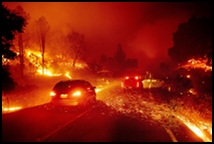
On the other hand, how do these costs compare with the sums needed to fight and repair huge and widespread drought-driven wildfires? How do these costs compare with the sum our descendants will have to pony up for dikes and levies around the coastal United States, as television news cameras show the low-lying islands of poorer Pacific and Indian Ocean nations slowly succumbing to rising waters? Or could the residents of Santa Barbara, Ventura, Los Angeles, Washington, D.C., New York City and New Orleans, like their compatriots in Shishmaref, Alaska, vote to move their cities inland?
And what of Alaska at this very moment? Republican Senator Ted Stevens, describing what he himself views as consequences of Arctic warming – sagging roads, crumbling villages, dead forests, catastrophic fires and possible disruption of marine life – has said these problems will cost his state hundreds of millions of dollars.
Most of our elected representatives might now and again have some thought of our children and grandchildren; but what concerns them more closely is their own careers. Some know they won’t be in office long should they disobey their fossil fuel-producing-distributing-using corporate campaign contributors. All believe they won’t be in office long should they create any earth-saving policy that will cost you and me more money. And make no mistake; it will cost us more, even if we act now. If we delay, the cost will escalate by an order of magnitude.
“Send not to know for whom the bell tolls,” wrote John Donne, “it tolls for thee.”
So the fateful decision is ours. Will we face it squarely? Will we swallow this pill? Or will we and our office-holders, like the legendary Roman emperor Nero, continue to fiddle while Earth burns.
REFERENCES
“Some Like it Hot,” by Bill McKibben, New York Review of Books, July 5, 2001.
“internet Atlas of Oceans Released,” by Edith Lederer, Associated Press, June 5, 2002.
“Japan Ratifies Global Warming Pact and Urges US Backing,” by Howard French, New York Times, June 5, 2002.
“Alaska … Starts to Crack, Bum and Sag,” by Timothy Egan, NY Times, June 16,2002.
“No Margin for Error,” by Bob Herbert, NY Times (Opinion), June 20, 2002.
“Study Links Warming to Epidemics,” by Usha Lee McFarling, Los Angeles Times, June 21, 2002.
“Wildfires Join and Threaten Arizona Town,” by Michael Janofsky, NY Times, June 24, 2002.
“How Hot is Too Hot?” by Bob Herbert, NY Times (Opinion), June 24, 2002.
IPCC Special Reports on Climate Change (web site), http://www.grida.no/climate/ipcc/>.
Climate/Gulf Stream (web site), <http://www.doc.mmu.ac.uk/aric/eae/Climate/Older/ Gulf_Stream.html>.
UN Oceans Atlas (web site), <http:// www.oceansatlas.com>.
Environmental News Network (web site), <http://www.enn.com/indepth/warming/ overview.asp>.
Kyoto Protocols (web site), <http: l/www.needham.k12.ma.us/high_school/cur/Baker-00/2002-p7/kyoto_protocols.htm>
